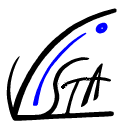
Summary:
The purpose of this mini-symposium is to invite four specialists working in the areas of patch-based modeling, sparsity and PDEs for image representation.
These methods serve various applications, such as denoising of images and videos, inpainting, super-resolution reconstruction, compression, ... leading to state-of-the-art results.
Our goal is also to establish connections between these different techniques, talk about important issues in this emerging field and generate novel ideas for future development.

Organizers: Vista group (http://www.irisa.fr/vista) at INRIA Rennes Center
Charles KERVRANN
Patrick PEREZ
Get the Flash Player to see this player.
|
David TSCHUMPERLE (GREYC (UMR-CNRS 6072): PDE's on the space of patches for image denoising and registration [49:41]] Abstract: Here we propose to define a very simple transform able to map any multi-valued image into an Euclidean space of patches, such that each existing image patch is mapped into a single high-dimensional point. We show that solving variational problems and PDE's on this particular space is an elegant way of finding the natural patch-based counterparts of some classical image processing techniques, such as anisotropic diffusion regularization and Lucas-Kanade registration methods. We end up with interesting variants of known patch-based algorithms, such as an anisotropic version of the Non Local Means algorithm and a variational block matching-based techniques with smoothness properties. We illustrate these non-local schemes by comparison results with corresponding non-variational and non-patch counterparts of the methods. |
Get the Flash Player to see this player.
|
Gabriel Peyré (CEREMADE, Université Paris Dauphine):The manifold structure of patches in images [54:31] Abstract: In this talk I will study the manifold structure of sets of patches extracted from natural signals and images. For some simple datasets such as cartoon images or turbulent textures, the local geometry of the signal can be described using a manifold parameterized with a small number of parameters. I will begin my talk by a description of this manifold structure for various ensembles suitable for natural signals, images and textures modeling. I will consider two approaches to incorporate these local manifold constraints into a classical signal and image processing pipeline, where the goal is to perform image restoration. The first one imposes that the signal/image should be close to a curve/surface traced on the feature manifold. This curve/surface should also match a given sets of measurements, in order to solve some inverse problems. The second approach uses differential operators on manifolds in order to regularize the signal/image viewed as a function defined on the feature manifold. This point of view shed light on the success of non- local image denoising methods such as NLmeans. This manifold analogy allows one to extend the NLmeans to a thresholding in an orthogonal basis adapted to the image content. I will show applications of these two approaches to denoising, inpainting, super-resolution, compressive sampling reconstruction and texture synthesis. |
Get the Flash Player to see this player.
|
Alessandro Foi (Tampere University of Technology, Finland): Removal of signal-dependent noise: the BM3D filter and optimized variance-stabilizing transformations [58:41] First, we review the Block-Matching and 3D filtering (BM3D) algorithm and its recent modification with Shape-Adaptive Principal Component Analysis. This class of algorithms exploits the nonlocal self-similarity of images by an adaptive 3D transform-domain shrinkage. It represents the state-of-the-art for the removal of i.i.d. Gaussian noise. In the second and main part of the talk, we consider the design of optimized nonparametric variance-stabilizing transformations. We approach the variance stabilization problem as an explicit optimization problem and propose recursive procedures to minimize a nonlinear stabilization functional that measures the discrepancy between the standard deviation of the transformed variables and the fixed desired constant. We demonstrate a number of optimized variance stabilizers for the most common distribution families. These stabilizers are shown to outperform the existing stabilizers. In particular, variance-stabilizing transformations optimized for low-count Poisson data are presented. The denoising of images from digital sensors is used as an illustrative combined application of optimized transformations with the BM3D filter. |
Get the Flash Player to see this player.
|
Julien Mairal (ENS/INRIA - project-team WILLOW): Sparse learned representations for image restoration [45:12]] Abstract: Sparse representations of signals have drawn considerable interest in recent years. The assumption that natural signals, such as images, admit a sparse decomposition over a redundant dictionary leads to efficient algorithms for handling such sources of data. In particular, the design of well adapted dictionaries for images has been a major challenge. Recently, Elad and Aharon have proposed to learn the dictionary for image denoising, which has shown to perform better than using off-the-shelf ones. In this talk, we present the framework of dictionary learning for various image and video processing tasks such has image and video inpainting or image demosaicking as well as some recent achievements to make this task efficient in terms of memory and computations. |
© avril 2009 Pôle audiovisuel de l'Irisa